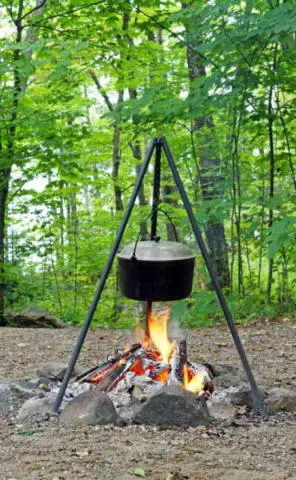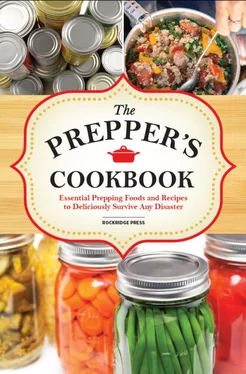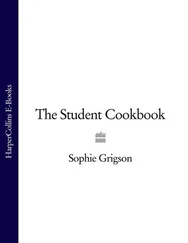THE PREPPERS COOKBOOK
Essential Prepping Foods and Recipes to Deliciously Survive Any Disaster
Regardless of what reality TV would have you believe, preppers aren’t paranoid people rushing around gathering food in underground bunkers and spouting conspiracy theories. Most are real-world people just like you, who simply want to be prepared to survive any emergency that may arise. These emergencies include natural disasters such as hurricanes or blizzards, as well as global emergencies such as economic collapse or war. For that matter, what if you simply lose your job and don’t have grocery money? If you have food stored away, your family won’t go hungry during those lean weeks.
Stocking enough food in advance is practical, too. When news of an emergency such as a hurricane or blizzard is announced, people rush to the store and clean the shelves. If you’re at work or otherwise unable to get to the store, there may be nothing left by the time you get there. If you stock up in advance, you don’t have to worry about any of that, because you’re already prepared.
There are several different ways to build an emergency food supply, including buying canned and dry goods, canning your own food, and dehydrating products. This book will teach you how to stock your pantry using a combination of these methods.

Why Create Home-Prepped Food?
Home canning and dehydrating are great ways to build an emergency food supply with a minimal investment. The best part is that you can prepare your own delicious, nutritious recipes instead of relying on tasteless, chemical-laden, commercially canned foods. It’s also significantly cheaper to can your own foods, after the initial equipment investment.
Two huge advantages to making your own food include the fact that you’ll know every single ingredient that goes into your recipes, and although most commercial products have a two-year marked shelf life, your products will retain their edibility and nutritional value for many years. As a matter of fact, there are documented cases of people eating food 100 years after it was canned. Although certainly not recommended, it goes to show that if you do it right, your food will last.
A Quick Start to Prepping
The following short checklist is to get you thinking about your emergency-preparedness plan. While the focus of this book is preparing stores of food for emergencies, this list will help you with your overall planning. At the back of the book, also see a checklist BUG-OUT BAG CHECKLIST
for a bug-out bag. Bug-out bags, discussed in more detail in Chapter 1 Building Your Bug-Out Bag If your house was on fire, a flood was coming, or another event requiring you to leave quickly occurred, wouldn’t it be good to have all of your important documents and some emergency items altogether in one spot where you could quickly grab them? Of course it would, and that’s exactly what a bug-out bag is: a bag that’s already packed with vital items and a small supply of food in case you need to “bug out” in a hurry. You may hear this emergency bag referred to by the following names: • 72-hour bag • GOOD (Get out of Dodge) bag • Go bag • PERK (Personal Emergency Relocation Kit) bag Regardless of what you call it, there are many different reasons to pack one. The idea originated with military personnel who were accustomed to being called out in a hurry and has been adopted by civilians who believe in being prepared. How Do You Decide What to Put in Your Bug-Out Bag? What food goes in your bug-out bag depends upon several factors, including: • What type of event you’re preparing for • Who’s going to carry it • How far it will be carried • Where you’re going to store it • Geographical needs Regardless of these factors, several items should be in every bug-out bag. See the back of the book for a bug-out bag checklist BUG-OUT BAG CHECKLIST that includes food, water, and some standard items that should be in every bag, plus some optional items such as medications, blankets, pet food, and maps.
, contain small amounts of food and supplies for quick get-aways.

These basic points will help you start building your emergency food supply. The next section focuses on different food-preservation methods and how to properly use each. You’ll also find some great recipes to get you started.
SECTION 1
Preparing Your Supplies and Food Stores

1
GETTING STARTED: FOOD PREPPING 101
As already discussed, you may not have access to modern amenities during an emergency, so you’re going to need food that’s been preserved in a manner that doesn’t depend on refrigeration or possibly even cooking. There are several different ways that you can do this, and this chapter previews some of the most popular and successful methods of food preparation and cooking featured throughout this book.
Alternative Cooking Methods
Many of the foods that you’re going to prepare are ready to eat, but if the emergency event extends beyond a day or two, you’ll get pretty tired of cold food. Also, if you’re a coffee drinker or a person who likes to wash in warm water, you’ll probably want to have a heat source handy that doesn’t require electricity. There are several options out there, and all of them have their ups and downs. It is best to have more than one cooking method available, just in case.
Open Wood Fires
Without a doubt, this is the most popular way to cook without power, especially if you need an alternative source of heat for more than a day or two. If you plan to cook over an open fire, you can either use a campfire-type pit or you can build a fire pit that already has racks, a flue, and whatever other accessories you’d like to build into it.
If you decide to cook with wood, you’ll need to have a plentiful stock of dried wood and a way to light it. Wet wood won’t burn and it will create an excessive amount of smoke that can affect the flavor of your food. Also, you can only use it outside, so plan to cook in all weather conditions if this is one of your methods.
Tools that you’ll need:
• Wood
• Rocks
• Rack, tripod, or special cooking rack with legs
• Iron skillets, a Dutch oven, iron or copper kettles, or any combination of these
• Wooden or metal spoons and spatulas with longer handles
• Pot holders or towels to move your cookware
• Cast iron or other metal fire poker or wooden stick

Barbecue Grill
You can always use your barbecue grill to cook with. Stock up on charcoal or fuel, and as with an open fire, be prepared to cook in inclement weather. The downside here is that fuel supplies are limited to what you store, although you can always burn wood in it if you run out of charcoal or propane. If you opt to do this, though, make sure you remove the fuel tanks completely prior to building a wood or charcoal fire in your gas grill.
Читать дальше
















